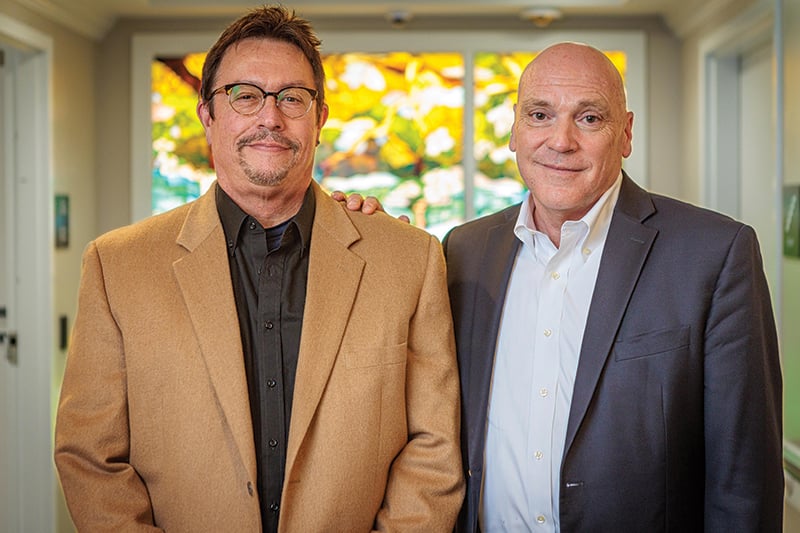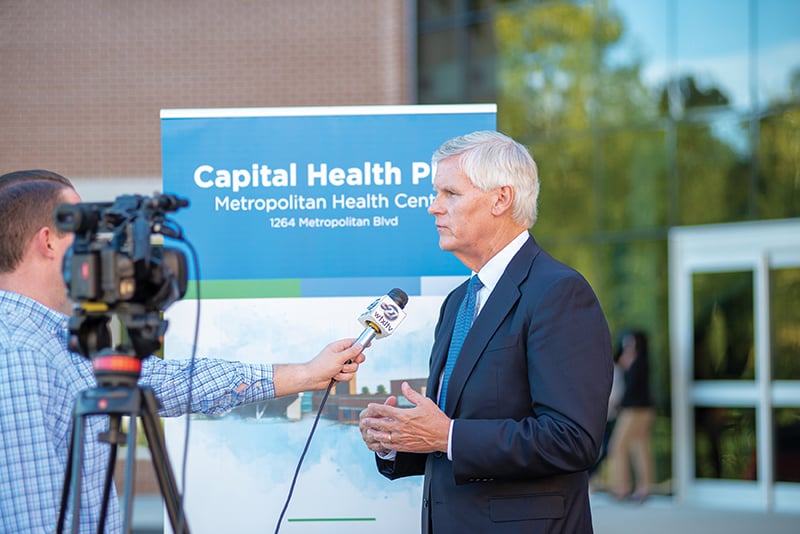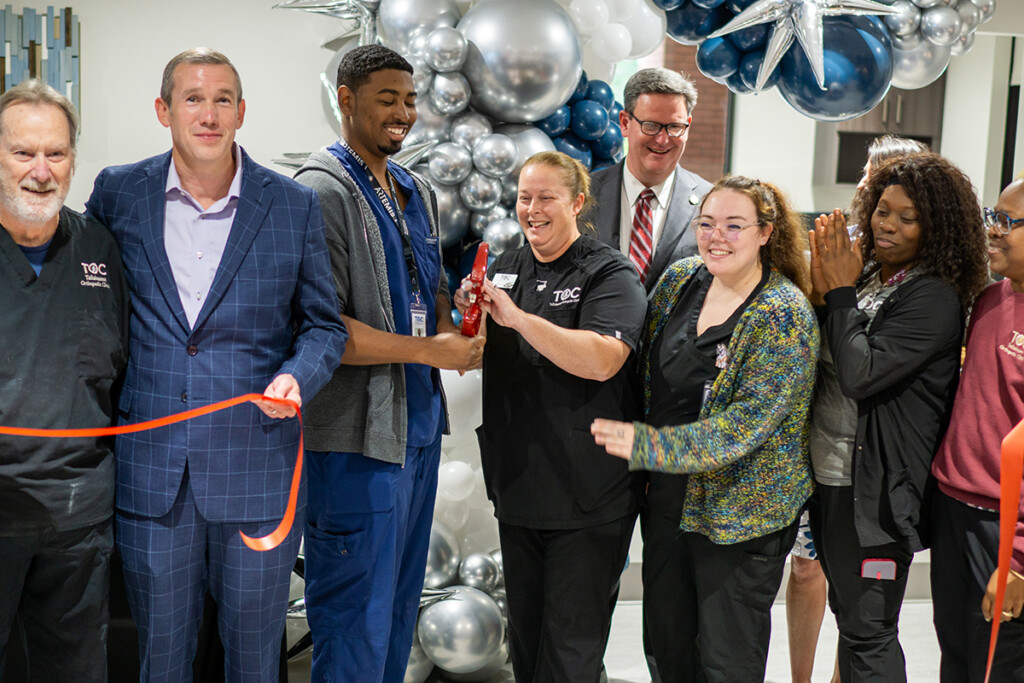Continuum of Care
Leaders seek seamless approach to services

In the United States, health services are delivered based on what Mark O’Bryant sees as a “reverse model.”
Some might even call it a perverse model.
“You get paid for treating people when they are sick,” said O’Bryant, the president and CEO at Tallahassee Memorial HealthCare Inc., the parent corporation of Tallahassee Memorial Hospital. “And, you get paid more when they’re sicker. You make your biggest dollars when you have your sickest patients. There is very little incentive to keep people well because you don’t get paid for it.”
That is to say, too, O’Bryant stressed, that the model is episodic in nature. A person develops a health issue and engages a health care provider who treats the patient and charges fees for services.
All of that is changing, according to O’Bryant, due to forces impinging upon health care systems including population dynamics.
U.S. health care spending grew 2.7% in 2021, reaching $4.3 trillion or $12,914 per person. As a share of the nation’s gross domestic product, health spending accounted for 18.3%, according to the U.S. Centers for Medicare & Medicaid Services (CMS). As recently as 1980, that percentage stood at 8.9%.
“Unfortunately, that number is growing because we have an aging population, and the demand curve certainly follows the age continuum,” O’Bryant said. “If we don’t watch it, that percentage is going to get to the point where it creates real problems for our economy. You can’t compete economically if one of every four dollars is going to health care. We have got to create different dynamics.
“If we are going to live longer, we need to be able to afford to do so. And not just live longer, but live well longer.”
The perverse system will have to be reformed.
O’Bryant firmly believes that in the near future, the fee-based model of reimbursement will evolve to become a value-based system.
“At the end of the day, we’re going to be measured and paid on how we manage a continuum of care,” he said.
Already, he is making plans and trying to get ahead of the curve, working in concert with Bill Wertman, the CEO at Big Bend Hospice (BBH).
“As we grow as an organization, understanding the changes that are coming down from CMS, we will have to find a more sustainable approach to health care,” Wertman said. “It is not going to be enough to simply be a hospice in the future. We will have to become a hospice that provides a number of other services in order to build scale. In the value-based world, as opposed to the fee-for-services world that we currently inhabit, payers are going to align themselves with organizations that are capable of achieving cost savings or sharing costs.”
For Wertman, payers equate almost exclusively to Medicare and Medicaid. The two entitlement programs supply BBH with 97% of its revenue. Increasingly, he said, they will be looking for health care service providers that “have scale, cover a lot of territory, and are partnered with other nonprofits in relationships adding up to a continuum of care.”

↑ From Womb to Tomb: U.S. health care spending grew 2.7% in 2021, reaching $4.3 trillion or $12,914 per person. As a share of the nation’s gross domestic product, health spending accounted for 18.3%, according to the U.S. Centers for Medicare & Medicaid Services (CMS). As recently as 1980, that figure stood at 8.9%. Photo by iStock Photo/Getty Images Plus: sezer66
That concept is illustrated, at least in microcosm, by the newly opened First Commerce Center for Compassionate Care, a hospice unit operated by BBH and located at Tallahassee Memorial Hospital. Its development was preceded by years of discussion among O’Bryant, Wertman and their respective board chairs, a dialogue that has now expanded in scope to include other possible relationships.
“Talking about hospice services opened the door to other conversations about what we can do in our community to improve care,” O’Bryant said. “All of us on the TMH and BBH teams are willing to look at what that might mean. We went from the inpatient hospice unit consideration to looking at the bigger picture.
“Bill brought some great strategists into his organization, and long story short, we found that there are synergies that we have the potential to capitalize on. But we might never have landed on them, had we not had an established relationship.”
Such interconnectedness characterizes Tallahassee, a community that O’Bryant thinks of as a “cosmopolitan Mayberry.” The city, he said, provides a great laboratory for developing, testing and refining new approaches to delivering health care.
COVID-19, too, advanced the dialogue in its way. A pandemic can serve as a mother of invention.
“We looked at emerging technologies and our experience during COVID, when we learned to do a lot more with remote monitoring and more telemedicine services,” O’Bryant said. “We in health care are not taking full advantage of that. So, the question comes to be how we could better use technology to enable people to receive certain levels of service at lower costs and at home, a place that they are comfortable and familiar with.”
Wertman and O’Bryant recognized that BBH and TMH have differing core competencies, and that there are health care services and activities that neither is engaged in. That realization led to their focus on a continuum whereby health care, from womb to tomb, might be made seamless, accessible, affordable and community-based.
“At the hospital, we take care of very sick, highly acute patients, everything from trauma to strokes to heart attacks,” O’Bryant said. “Those are always, to a degree, going to take precedence over other areas. But I can see 20–30% of the cases we have in the hospital today being treated at home, if we can monitor patients properly. If you can use technology to create an observation platform in the home and give people access to resources on a timely basis, then you could see a big chunk of what we do here move to a different, lower-cost environment.”
In the future, O’Bryant envisions, TMH will function as a big intensive and intermediate care unit by providing high levels of care while relying on a partner to address transitional and rehabilitative care.
Supplying those less acute types of care should not be a secondary project for TMH, O’Bryant said. Instead, it needs the primary role of an entity committed to making it its top priority.
Accordingly, Wertman has created a new nonprofit, Seven Oaks, which is focused as O’Bryant suggests. It is governed by a board made up of the same people that comprise the BBH board. In addition, a TMH board member will sit on the BBH and Seven Oaks boards and vice versa.
“Seven Oaks is going to take this new transitional care model, and they are going to be the drivers of the transitional care strategy,” O’Bryant said.
Wertman and O’Bryant are confident that a reliable continuum of care delivered by community-based nonprofits will make for a healthier Tallahassee and Northwest Florida.
TMH and BBH have a shared vision and cultures that align, Wertman said.

↑ Parents, above, participate in an online medical consultation from the comforts of their home. Tallahassee Memorial HealthCare president and CEO Mark O’Bryant envisions that 20–30% of today’s in-hospital cases will one day be treated at home, given the ability to properly monitor patients remotely. Photo by iStock / Getty Images Plus: Valeriy_G
“TMH has a number of organizations that they work with, and so do we,” he added. “By coming together, we can coalesce in an even stronger network that will reach people in outlying communities and in rural areas. We will be working on a more robust model for health care delivery that will include home-health and palliative care in addition to creating more opportunities for 24/7 health care.”
TMH has involved Dr. Jing Wang, dean of the FSU College of Nursing, in its research into extending care to populations including underserved groups. In 2023, she and two other researchers combined to write an article about how artificial intelligence can be incorporated in homes and hospitals through various digital health platforms, embedded with sensors, wearables and remote monitoring devices.
Technology is sure to play an expanding role in efforts to take health care to the house.
Notions of house and home are central to O’Bryant’s outlook.
“Tallahassee is my home, and if I’m going to be a patient in Tallahassee, I don’t want to have someone a thousand miles away making decisions about the kind of health care we are going to have in our community,” he said. “We have board members from our community, we have doctors who live here and aren’t just rotating in and out. Health care is better when driven locally. Our accounts aren’t stripped nightly. We are able to retain and reinvest our resources locally.”
O’Bryant often thinks about a comment made by John Hogan, who retired last year after more than four decades as the chief executive at Capital Health Plan in Tallahassee.
Paraphrasing Hogan, O’Bryant said, “You better make community-based health care good because you’re gonna see everyone in town at the Walmart, at Publix, at church or somewhere. And you have to answer to them. You can’t hide from them in cosmopolitan Mayberry. We live here. And that’s a good thing.”


